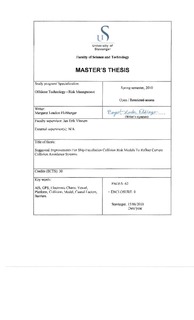| dc.contributor.author | Flohberger, Margaret Loudon | |
| dc.date.accessioned | 2010-10-01T14:00:35Z | |
| dc.date.available | 2010-10-01T14:00:35Z | |
| dc.date.issued | 2010 | |
| dc.identifier.uri | http://hdl.handle.net/11250/182724 | |
| dc.description | Master's thesis in Offshore technology | en_US |
| dc.description.abstract | Accurate quantification of risks for vessel-to-platform collisions has been a goal of the
petroleum industry for many years; however, technological advances in collision avoidance
systems have not been reflected in current models. Additionally, new modeling theories have
been developed which capture the complexities of modern socio-technical systems. This
paper recommends that a new collision model be developed to reflect current collision
avoidance systems.
Today’s navigation tools
Current models for collision probability between platforms and passing vessels were
developed prior to the rapid expansion of GPS, electronic charts and AIS.
Causal factors of ship- platform collisions
Accidents are often the result of multiple factors. Causal factors considered by current
models are still very relevant today; but, because voyage planning procedures have changed
in response to new technology, causal factors may have changed as well.
Barriers to prevent collisions with platforms
Technological advances have enhanced detection and communication barriers to prevent
collisions. GPS and electronic charts offer the vessel’s navigator improved situational
awareness. With AIS, both the vessel and the platform are able to detect each other faster at a
distance of approximately 40 nautical miles, compared to the 12 nautical mile radius offered
by conventional radar.
Alternative modeling theories
Today’s accident models are based on fault trees and event trees. They provide a sequence of
events that must occur prior to a collision. As technology improves and the complexity of
socio-technical systems increases, these models will become less relevant.
Suggested structure for a revised collision risk model
Flexible simulation software is available and should be utilized to model the complexity
behind a vessel-platform collision. The suggested structure presented in this paper starts with
four main systems: the vessel, the platform, VTS, and external conditions. | en_US |
| dc.language.iso | eng | en_US |
| dc.publisher | University of Stavanger, Norway | en_US |
| dc.relation.ispartofseries | Masteroppgave/UIS-TN-IKM/2010; | |
| dc.subject | offshoreteknologi | en_US |
| dc.subject | AIS | en_US |
| dc.subject | GPS | en_US |
| dc.subject | electronic charts | en_US |
| dc.subject | vessel | en_US |
| dc.title | Suggested improvements for ship-installation collision risk models to reflect current collision avoidance systems | en_US |
| dc.type | Master thesis | en_US |
| dc.subject.nsi | VDP::Technology: 500::Marine technology: 580::Offshore technology: 581 | en_US |
| dc.source.pagenumber | 62 p. | en_US |
